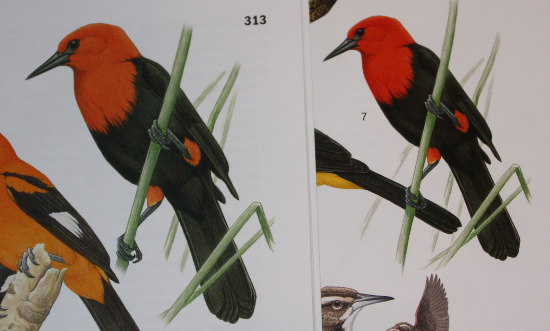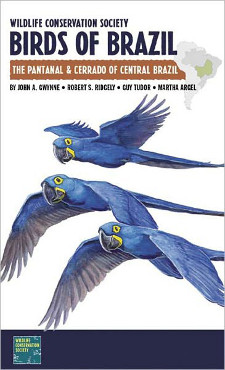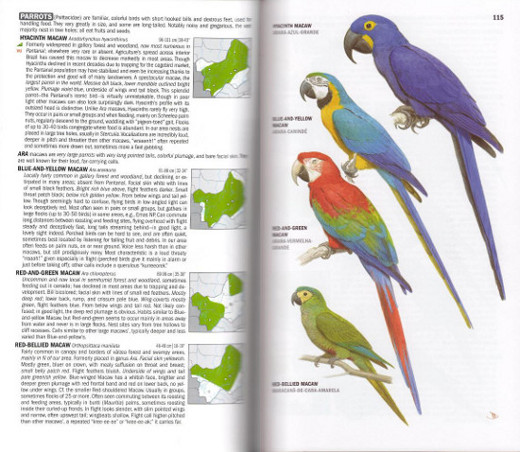Reviewed by Grant McCreary on July 10th, 2012.
Brazil is big. And birdy. Specifically, it – the world’s fifth largest nation – hosts over 1800 birds, many of which are endemic or threatened. It’s no wonder this is a popular birding destination. However, it is a bit of a surprise that until recently Brazil hasn’t had a serviceable field guide. One impediment has been the sheer number of species. The Wildlife Conservation Society is avoiding this issue by producing a series of region-specific field guides for this vast country.
Birds of Brazil: The Pantanal and Cerrado of Central Brazil, the first in this series of five field guides, covers 740 birds found in the Pantanal and Cerrado regions of Central Brazil. That is still a lot of birds, but this guide manages to fit them all onto uncrowded plates with relatively large images, along with range maps and text accounts. And it does so in a guide that can comfortably be carried in the field.
Illustrations
Birds of Brazil follows the standard field guide format of painted plates on the right-hand page with text and range maps on the left side. On average, each plate depicts five species. Males and females, when they differ, are usually both illustrated. Immatures are sometimes shown, but only among the non-passerines. Many species routinely seen in flight – such as the raptors, parrots, and swallows – are shown both perched and in flight. The plates are labeled with the species name (in both English and Portuguese) and other relevant identifiers such as male/female symbols, “nonbreeding adult”, etc.
Eight different artists contributed illustrations for this field guide, and even a casual glance through will reveal a mixture of styles. For the most part, though, they look good to me (but I should mention that I have personal experience with a very small number of these birds). The passerines fare the best, in my opinion. For them, this guide uses Guy Tudor’s illustrations that originally appeared in The Birds of South America, Volume 1 and Volume 2
, and later in Field Guide to the Songbirds of South America
(henceforth SoSA). Tudor is a highly-regarded illustrator, and it is easy to see why. Unfortunately, their reproduction here doesn’t do them justice. Some of the plates, especially the tanagers, look great. But many appear washed out, as if the contrast were too low. The flycatchers, especially, look off, and a quick comparison to SoSA confirms this to be true. Other plates are also wrong, but less obviously so. For instance, the Scarlet-headed Blackbird here is more orange than scarlet – very unimpressive. But when I compared it to SoSA, it immediately became a Bird I Must See. The same issue also plagues The Birds of Costa Rica
, also from Cornell University Press.

Scarlet-headed Blackbird in Birds of Brazil (left) and Songbirds of South America (right). Many of the passerine plates in Birds of Brazil seem to have lost their vibrancy.
Species Accounts
The text accounts, by Robert S. Ridgely, contain:
- Name – English and scientific
- Size – length in centimeters and inches
- Abundance and Status
- Description
- Similar Species
- Behavior and Habitat
- Vocalizations
Additionally, a small Brazilian flag next to the text indicates a bird endemic to Brazil, and a half flag means that it is a near-endemic. Endangered and vulnerable birds are also noted.
The text, at least that of the passerines, is also based on the aforementioned The Birds of South America series, but tailored to the area covered here. The accounts are fairly extensive, even including conservation information where appropriate. Unfortunately, the various sections within the text are not marked in any way, making the accounts one large block of text that is harder to read.
The range maps are a good size (just over an inch square), depicting the bird’s range within the region covered in this field guide. Different colors indicate the ranges of permanent residents and that of boreal and austral migrants. Dots show isolated areas of occurrence. In a nice touch, the maps also show state boundaries as well as major rivers and cities.
Comparison to Other Guides
At the moment, the primary field guide for Brazil is A Field Guide to the Birds of Brazil (2009), by Ber van Perlo. Covering the entire country, it is slightly larger than this Pantanal and Cerrado guide. I’m not a big fan of van Perlo’s art, and the text accounts are much less extensive than Ridgely’s. However, I would still want to take van Perlo on any trip to Brazil. But for a trip exclusively to the Pantanal and Cerrado region, the field guide reviewed here would certainly be sufficient.
I think it was a great idea to break up this project into region-specific guides. It allows the text to be more thorough and relevant while keeping the guides from being too large and unwieldy. However, the main thing that sets the Wildlife Conservation Society’s Birds of Brazil series apart from other field guides is its explicit focus on conservation. As the authors state in the introduction:
[This is] more than just a series of field guides, this project is the centerpiece of a broader mission-to spark widespread interest and initiatives in conservation among the people of Brazil and create a pathway toward that goal by providing comprehensive information about the extraordinarily rich birdlife of Brazil, region by region.
I applaud this approach, which is clearly evident in the guide. For instance, instead of covering the usual topics, like bird topography, in the introduction, this guide instead features the various habitats of the region as well as conservation threats and successes. These are topics that I, as a visiting birder, would really appreciate. And honestly, the introduction alone makes me want to visit this area even more than I did before!
Other than the printing issues, I only found one actual error – there is a mix up with the illustration of the male Band-tailed Manakin. The bird shown is actually a Crimson-hooded Manakin (according to SoSA). I also noticed that the illustration of the male Black-tailed Tityra from SoSA wasn’t included in this guide, even though there would have been room for it.
Recommendation
I love the concept and goals of this series of field guides by the Wildlife Conservation Society and Cornell University Press, of which Birds of Brazil: The Pantanal and Cerrado of Central Brazil is the first. Honestly, though, I have to say that I’m very disappointed with the colors of the passerine plates and other issues that I found. However, this field guide is still a must for anyone birding in this region. I hope it succeeds in raising awareness of Brazilian conservation and encourages more birders to visit.
Disclosure: I get a small commission for purchases made through links in this post.
Disclosure: The item reviewed here was a complementary review copy provided by the publisher. But the opinion expressed here is my own, it has not been influenced in any way.







 (4 votes, average: 3.25 out of 5)
(4 votes, average: 3.25 out of 5)
Comment